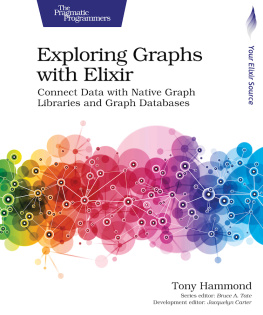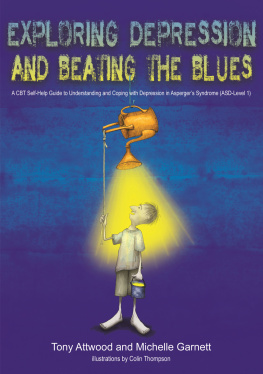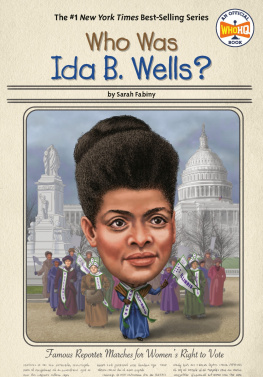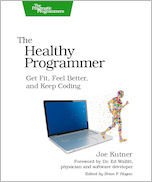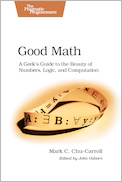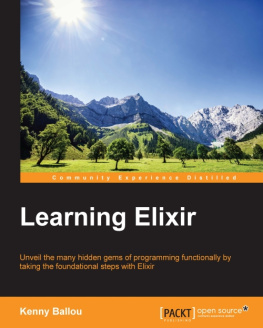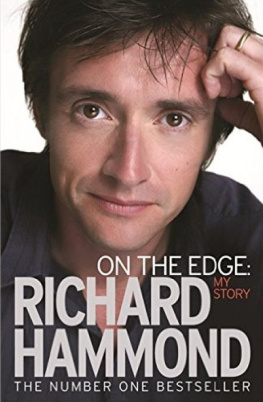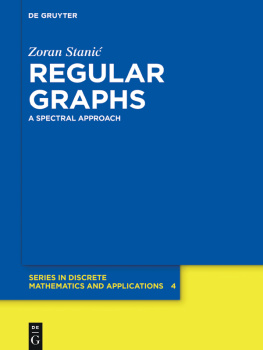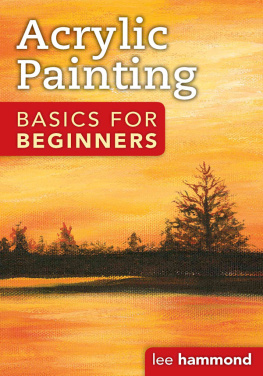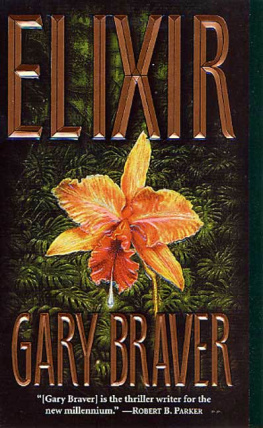Tony Hammond - Exploring Graphs with Elixir
Here you can read online Tony Hammond - Exploring Graphs with Elixir full text of the book (entire story) in english for free. Download pdf and epub, get meaning, cover and reviews about this ebook. year: 2022, publisher: Pragmatic Bookshelf, genre: Home and family. Description of the work, (preface) as well as reviews are available. Best literature library LitArk.com created for fans of good reading and offers a wide selection of genres:
Romance novel
Science fiction
Adventure
Detective
Science
History
Home and family
Prose
Art
Politics
Computer
Non-fiction
Religion
Business
Children
Humor
Choose a favorite category and find really read worthwhile books. Enjoy immersion in the world of imagination, feel the emotions of the characters or learn something new for yourself, make an fascinating discovery.
- Book:Exploring Graphs with Elixir
- Author:
- Publisher:Pragmatic Bookshelf
- Genre:
- Year:2022
- Rating:5 / 5
- Favourites:Add to favourites
- Your mark:
- 100
- 1
- 2
- 3
- 4
- 5
Exploring Graphs with Elixir: summary, description and annotation
We offer to read an annotation, description, summary or preface (depends on what the author of the book "Exploring Graphs with Elixir" wrote himself). If you haven't found the necessary information about the book — write in the comments, we will try to find it.
Exploring Graphs with Elixir — read online for free the complete book (whole text) full work
Below is the text of the book, divided by pages. System saving the place of the last page read, allows you to conveniently read the book "Exploring Graphs with Elixir" online for free, without having to search again every time where you left off. Put a bookmark, and you can go to the page where you finished reading at any time.
Font size:
Interval:
Bookmark:

Copyright 2022 The Pragmatic Programmers, LLC. This book is licensed to the individual who purchased it. We don't copy-protect it because that would limit your ability to use it for your own purposes. Please don't break this trustyou can use this across all of your devices but please do not share this copy with other members of your team, with friends, or via file sharing services. Thanks.
Many of the designations used by manufacturers and sellers to distinguish their products are claimed as trademarks. Where those designations appear in this book, and The Pragmatic Programmers, LLC was aware of a trademark claim, the designations have been printed in initial capital letters or in all capitals. The Pragmatic Starter Kit, The Pragmatic Programmer, Pragmatic Programming, Pragmatic Bookshelf and the linking g device are trademarks of The Pragmatic Programmers, LLC.
Every precaution was taken in the preparation of this book. However, the publisher assumes no responsibility for errors or omissions, or for damages that may result from the use of information (including program listings) contained herein.
The Pragmatic Bookshelf is an agile publishing company. Were here because we want to improve the lives of developers. We do this by creating timely, practical titles, written by programmers for programmers.
Our Pragmatic courses, workshops, and other products can help you and your team create better software and have more fun. For more information, as well as the latest Pragmatic titles, please visit us at http://pragprog.com.
Our ebooks do not contain any Digital Restrictions Management, and have always been DRM-free. We pioneered the beta book concept, where you can purchase and read a book while its still being written, and provide feedback to the author to help make a better book for everyone. Free resources for all purchasers include source code downloads (if applicable), errata and discussion forums, all available on the book's home page at pragprog.com. Were here to make your life easier.
Want to keep up on our latest titles and announcements, and occasional special offers? Just create an account on pragprog.com (an email address and a password is all it takes) and select the checkbox to receive newsletters. You can also follow us on twitter as @pragprog.
If you buy directly from pragprog.com, you get ebooks in all available formats for one price. You can synch your ebooks amongst all your devices (including iPhone/iPad, Android, laptops, etc.) via Dropbox. You get free updates for the life of the edition. And, of course, you can always come back and re-download your books when needed. Ebooks bought from the Amazon Kindle store are subject to Amazon's polices. Limitations in Amazon's file format may cause ebooks to display differently on different devices. For more information, please see our FAQ at pragprog.com/#about-ebooks. To learn more about this book and access the free resources, go to https://pragprog.com/book/thgraphs, the book's homepage.
Thanks for your continued support,
The Pragmatic Bookshelf
The team that produced this book includes: Dave Rankin (CEO) Janet Furlow (COO) Tammy Coron (Managing Editor) Series editor: Bruce A. Tate Jacquelyn Carter (Development Editor) Corina Lebegioara (Copy Editor) Potomac Indexing, LLC (Indexing) Gilson Graphics (Layout) Andy Hunt and Dave Thomas (Founders)
For customer support, please contact .
For international rights, please contact .
This book opens up and makes accessible a technology which few developers have used so far in creating cutting-edge products, especially in the Elixir world. It will help Elixir software developers understand better why graph technology is great, and how easy it is to use to build applications in ways they had never thought of before.
| Dmitry Russ |
| Lead Engineer, Appian Corporation |
In Exploring Graphs with Elixir, Tony takes the reader through a hands-on journey with several major graph databases. While I had worked with a few already, the hands-on comparison across several provided a refreshing perspective. Enrich yourself by joining Tony on this journey and confidently tackle your next graph problem with ease.
| David Swafford |
| VP, Product Engineering, LynkState |
I really like that this book gives such a full overview of contemporary ways of working with graphs. I have never read anything that brings all the different types of graphs together so comprehensively, and I feel that for this reason the book gives valuable insights even to people like myself who are not working with Elixir.
| Tony Seale |
| Developer, UBS |
This book presents cutting-edge topics that will be of interest to developers working in the field and utilizing graph databases, and it is certain to be a very valuable resource.
| Eoghan ODonnell |
| Senior Staff Engineer |
Acknowledgments
My beginning with this book, I suppose, was almost 30 years ago, in the sunshine, in Italy. I had just discovered the web and the graph of documents. Since then, I have been hooked. I dont think I had ever really focused on graphs much before that.
Then after a handful and more years, I got hooked again a second time with the semantic web. I had the good fortune to work on a number of linked data projects in my day job in science publishing over the next twenty years. And then when that run eventually came to an end, I was lucky enough to find the time to do some new learning, explore Elixir, and start working on this book.
For the last couple of years, Ive been working for a new outfit to build out a knowledge graph. Ive continued to learn still more with a whole new group of incredible colleagues while having competing demands on my time to finish this book. But now its done.
My first callout is to Marcel Otto. When I was learning Elixir, I also wanted to see if I could apply it to any domain with which I was familiar. Was there any support in Elixir for graphs, especially RDF graphs? Marcel was there and had the whole thing covered with his wonderful set of Elixir packages ( rdf , sparql , sparql_client , and json_ld ). He has also been especially helpful to me both at the beginning of this trek and several times since in answering questions I have had.
Id also like to thank the developers of the other Elixir packages Ive usedin this book. They all have taken the time to answer my questions: PaulSchoenfelder ( libgraph ), Florin Ptracu ( bolt_sips ), Barak Karavani( gremlex ), and Dmitry Russ ( dlex ).
I didnt shop around for a publisher. I didnt have to. I only had The Pragmatic Bookshelf in my sights ever since they published the PickAxe Book. That book was such a joy to read. That publisher was the one for me.
As series editor, Bruce Tate has been really supportive in helping this book become a reality, believing in it, and helping me turn a bunch of blog posts into a more coherent package.
And then also my development editor Jackie Carterwhat can I say? Maybe I should have listened to her from the outset. But then I had to learn for myself. She has kept me focused and helped me find a simpler, more direct voice. She has helped me turn my various writings into a book. She has stayed with me throughout this long haul.
Font size:
Interval:
Bookmark:
Similar books «Exploring Graphs with Elixir»
Look at similar books to Exploring Graphs with Elixir. We have selected literature similar in name and meaning in the hope of providing readers with more options to find new, interesting, not yet read works.
Discussion, reviews of the book Exploring Graphs with Elixir and just readers' own opinions. Leave your comments, write what you think about the work, its meaning or the main characters. Specify what exactly you liked and what you didn't like, and why you think so.

